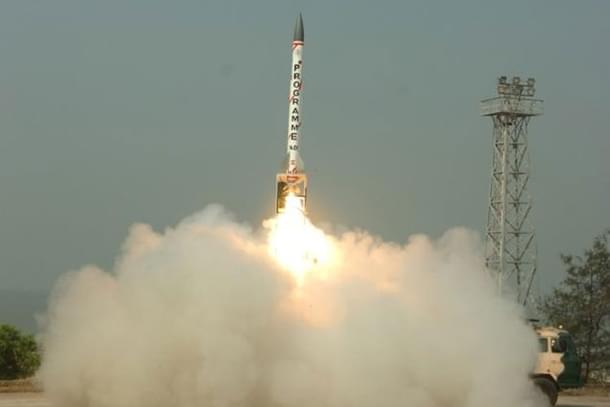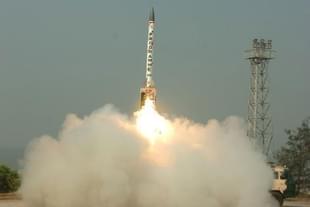Defence
How India’s Missile Defence System Can Take Down Pakistan
Rakesh Krishnan Simha
May 29, 2016, 02:20 PM | Updated 02:20 PM IST
Save & read from anywhere!
Bookmark stories for easy access on any device or the Swarajya app.


India’s claim that its indigenously designed ballistic missile defence (BMD) system – successfully tested on May 15 – can defend the country from a nuclear attack is being contested by a Russian expert.
According to Petr Topychkanov, Associate at the Carnegie Moscow Centre’s Non-Proliferation Programme, despite heavy investments in developing BMD systems, India may not be able to fully defend itself in a conflict from strikes by Pakistani missiles. “Even in 10 years and with the huge budgets that India plans to spend on the development of nuclear weapons and capabilities, it is difficult to imagine it will be able to defend its territory from possible strikes from Pakistan in case of conflict,” he says.
Topychkanov’s observation isn’t wrong. Although India is now only the fourth country after Russia, Israel and the US to successfully test a BMD system, it is currently taking baby steps in ballistic missile development. BMD technologies are complicated and it will take years – and perhaps decades –before India gets a reliable system.
Even the superpowers with huge economic and technological resources at their disposal did not erect iron domes over their territories. During the Cold War despite thousands of Russian nuclear-tipped missiles pointed at its cities and strategic nerve centres, the US abandoned its lone BMD site, in North Dakota. The Russians also built just one system, over Moscow, with the difference that it stands to this day.
But Topychkanov’s opinion doesn’t provide the complete picture. India’s BMD programme is not a zero-sum project that will either protect the country or won’t. Rather, it is part of a strategic escalation that will have far-reaching geopolitical impact, especially on Pakistan.
Playing strategic chicken
A detailed study titled ‘On the Strategic Value of Ballistic Missile Defence’ by the French Institute of International Relations explains how BMD works to unhinge the enemy’s strategy. According to the study, BMD:
- Creates uncertainty about the outcome of an attack in the mind of the attacker.
- Increases the raid size required for an attack to penetrate, thereby, undermining a strategy of firing one or two and threatening more thus reducing coercive leverage.
- Provides some assurance against risks of precipitate action by the aggressor.
- Buys leadership time for choosing and implementing courses of action, including time for diplomacy.
- Reduces the political pressure for pre-emptive strikes.
In short, a robust missile defence system helps to put the burden of escalation in an emerging crisis on to the adversary. When a crisis has become a hot war, then missile defence again has various strategic values. It:
- Helps to preserve freedom of action by selectively safeguarding key military and political assets.
- Increases time and opportunity to attack adversary’s missile force with kinetic and non-kinetic means, potentially eliminating his capacity for follow-on attacks or decisive political or military effects.
Pakistan’s conundrum
India’s development of a missile defence system will complicate the Pakistani military’s war planning. The Indian Army’s Cold Start strategy, for instance, has put huge pressure on the Pakistani economy by forcing Islamabad to crank up the production of nuclear weapons as well as delivery systems such as ballistic, cruise and tactical missiles.
The latest Indian test is likely to create more insecurity in the Pakistani military establishment. According to a report by the World Politics Review, “India’s pursuit of strategic technologies, including BMD capabilities, has created extreme paranoia in the Pakistani defence and security establishment. Pakistan has already drastically increased its nuclear arsenal in recent years in response to India’s BMD efforts.”
Pakistan is not content with having an adequate number of nuclear weapons to deter India from launching an attack. It wants to match India nuke for nuke. The Bulletin of the Atomic Scientists says Pakistan is on course to have the world’s fifth-largest inventory of nuclear weapons, and is spending more than $2.5 billion on nuclear weapons annually.
Given the Pakistani obsession with matching India weapon for weapon, it is likely Islamabad will try and develop a Made in Pakistan BMD. At the same time, it will attempt to buy systems from outside as a hedge against failure.
Either way the impact on the Pakistani economy will be immense. The Stockholm International Peace Research Institute lists India as the fifth largest military spender with an annual budget of $51 billion. In contrast Pakistan’s military budget is a paltry $7.6 billion. In overall economic terms, India’s GDP of $2 trillion is the seventh largest and dwarfs Pakistan’s $269 billion economy which is ranked 41st in the world.
Considering such economic disparities, there’s no way Pakistan can match India missile for missile. Overspending on defence could well bankrupt Pakistan, especially in the backdrop of western economies no longer having the inclination or the capacity to bail it out as they did in the past.
Will Islamabad take the bait?
Pakistan’s military leadership is obsessed with growing its atomic arsenal to the detriment of its economy. Terrence P. Smith of the Center for Strategic and International Studies says that for Pakistan, nuclear weapons have become a “psychological equaliser”.
“In working to double the size of its already substantial nuclear arsenal, Pakistan continues to place a disproportionate focus on its nuclear programme ahead of other key security concerns. This behaviour is far from new. In 1972, Pakistani President Zulfikar Ali Bhutto famously proclaimed, ‘Even if we have to eat grass we will make nuclear bombs’. Four decades later, Pakistan continues to pursue this strategy of nuclear buildup at any cost, thereby diverting resources away from other programmes that could attempt to address the country’s internal security and economic threats.”
India’s BMD could be the proverbial straw that breaks the back of the Pakistani camel.
Spinoffs for India
While any military spending is wasteful, it is a bit like insurance premiums – they hurt but when there’s a crisis you are glad you invested. Besides the obvious benefits, missile defence research could have lucrative spinoffs. Russia’s extensive R&D in strategic missile defence led to the development of battlefield missile defence systems such as the S-300, S-400 and S-500, of which the first two are in great demand worldwide. Similarly, India can be an exporter of low cost battlefield missile defence systems.
Rakesh Krishnan Simha is a New Zealand-based journalist and writes on defence and foreign affairs for Russia Beyond the Headlines, a global media project of Moscow-based Rossiyskaya Gazeta. He is on the advisory board of Europe-based Modern Diplomacy.Rakesh’s articles on defence and foreign have been quoted extensively by a number of leading think tanks, universities and publications worldwide. He has been cited in books on counter terrorism and society in the global south.





